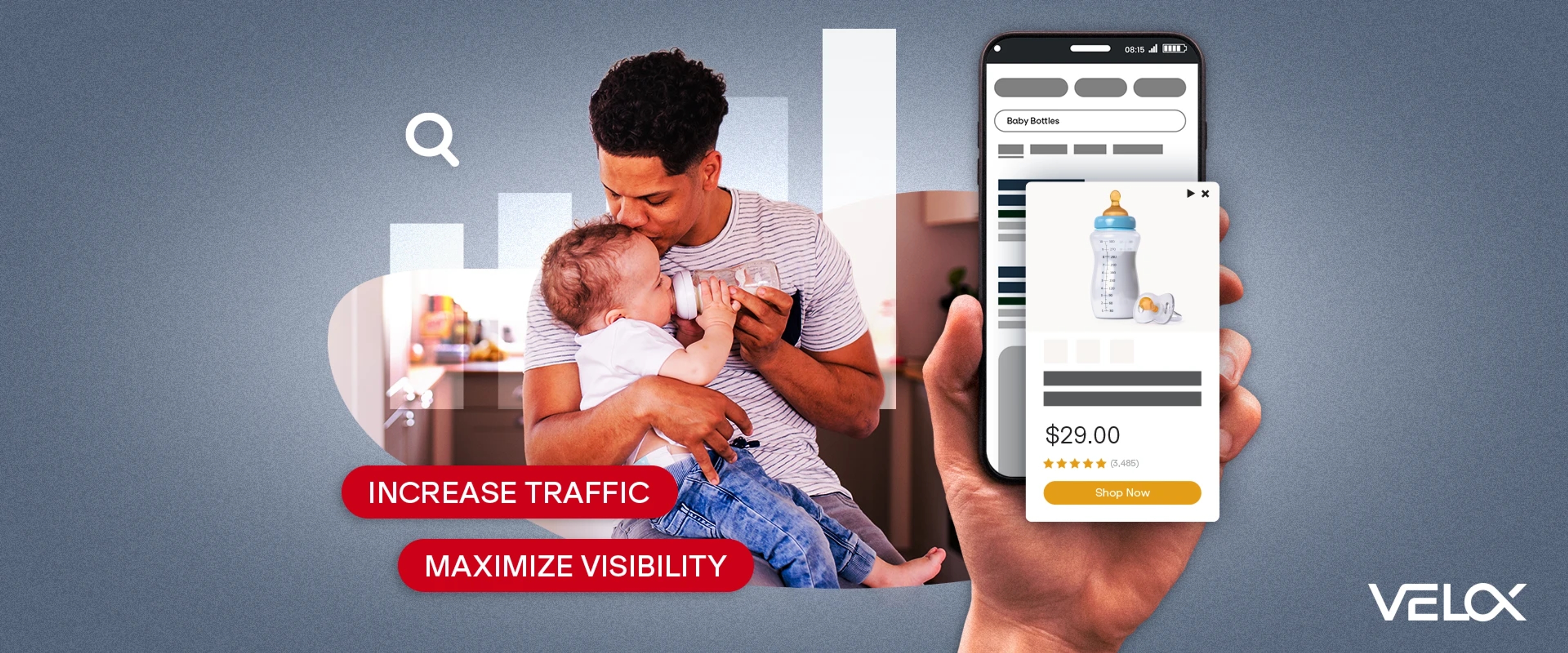

The State of Baby Product SEO in 2025


The global market for baby care products could top $88 billion by 2026, an incredible increase from the estimated market value of $67.3 billion in 2020.
Maximizing your brand’s search visibility is key to capturing the traffic, conversions, and revenue required to scale your business. Among digital channels, Organic Search is renowned as the most valuable due to its peerless ROI.
That’s why so many baby product companies invest in Organic Search marketing.
Ready to optimize your website for Organic Search visibility? Here’s a look at the strategies and tactics that can take your baby brand to the next level.
2025 Organic Search Fundamentals for Baby Brands
No matter how digital marketing changes, some baseline Organic Search best practices need to be implemented before your baby products brand can improve its Organic Search rankings.
You don’t need to get granular right away with a deep dive into Google’s myriad ranking signals.
Instead, start by learning about and focusing on these primary elements of a strong Organic Search presence.
Keyword Relevance & User Intent
First things first: If the page you’re trying to rank isn’t relevant to the associated keyword or user intent, you shouldn’t expect to see any positive results. That’s because relevance is the first thing Google looks at when organizing the SERP for a given query.
Because relevance is so fundamental to Organic Search success, it’s a vital factor to consider from the very beginning of your campaign. That means you should consider relevance and user intent during your keyword research process.
Keyword research is crucial to Organic Search success, but all too often, digital marketers tend to get tunnel vision during this process, focusing entirely on search volume and keyword difficulty.
While these considerations are key to choosing valuable keywords, they’re only worthwhile if the pages you’re trying to promote are truly relevant to the keyword(s) you’re targeting and the user intent behind them. There are no optimizations you can implement that will overcome a lack of relevance, so choose your keywords and landing pages wisely, always keeping in mind the user's intent for a search query and the solution you can provide to answer that query.
Website UX
No one wants to waste their time on a site that loads slowly, is difficult to navigate, or offers a poor experience on mobile devices. That’s why Google evaluates UX and uses it as a primary ranking factor in Organic Search results.
If you have an existing site and you want to optimize your UX, the best place to start is Google Search Console. Check out the Page Experience section and look at the Core Web Vitals metrics.
Here, you’ll see a breakdown of the issues impacting your Core Web Vitals scores, the URLs affected, and information about how to resolve any problems.
Beyond GSC, you can use the PageSpeed Insights tool to inspect individual URLs to better understand the technical performance of each page.
Remember, no matter how well you establish relevance to your priority keywords or how original your on-page content may be, a subpar UX will hold you back in a big way. Don’t overlook opportunities to optimize your baby brand site in this regard.
How Google’s Latest Updates Will Affect Baby Product SEO
While Organic Search fundamentals are vital, you can make the most of your efforts by keeping up with the latest Google Search updates and the direction in which this leading search engine is growing.
Here’s an overview of the crucial adaptations Google has made recently, and why each of these changes matters to your baby products brand.
AI-Organized SERPs
The biggest change of late is certainly Google’s move to using AI to organize results pages.
Initially, this was rolled out for just the recipe and meal planning categories, and only in the U.S. But now Google AI Overviews (AIOs) appear in SERPs primarily for informational queries and only rarely for queries centered around transactional keywords.
Of course, users benefit from more personalization when searching for baby products online. This aligns with Google’s mission to give users exactly what they’re looking for, with minimal input required.
So even if your baby brand's main focus is to sell products online, consider your customer's perception of your expertise and authority in the industry. If your content marketing strategy includes publishing informational blog content, optimize it for AI Overviews using these best practices:
- Target long-tail, informational keywords since these trigger most AIOs.
- Publish helpful content that delivers genuine value to real humans, a point of emphasis for Google since the first Helpful Content Update.
- Tailor content to your readers and speak to specific customer personas to address their particular pain points.
- Write with your users' questions in mind, with titles and subheads in the form of questions and clear answers directly below.
- Add unique value showcasing your brand's original perspective that isn't available anywhere else on the web.
- Keep your content current so potential customers don't land on a page with outdated information.
For more details on how to get your baby brand featured on AI-Organized SERPs, check out Google AI Overview: How to Use It in Your Content Marketing Strategy.
On-Page Content
Google Search underwent a significant sea change beginning in late 2022 with the release of the Helpful Content Update. The world’s dominant search engine hasn’t been the same since.
In essence, Google’s focus on helpful content is part of the effort to satisfy search intent to the fullest extent possible. “Thin” content is no longer enough to help your pages rank highly in organic results.
Even e-commerce baby brands that previously didn’t emphasize a content strategy are now learning the importance of content optimization.
Robust, honest product descriptions are a must, but the value of content goes even further. You can spruce up your collections pages with buying guides, FAQs, how-to guides, and other content to make these pages more helpful to your users.
As mentioned in the previous section, you should be publishing new blog posts regularly. This helps establish your brand as a leading informational resource within your industry and shows search engines that your brand is positively contributing to the digital ecosystem.
No matter what type of on-page content you’re creating, honing and maintaining your brand voice is key to success. As a baby products brand, you’ll want to speak directly to parents, with consideration for the unique life experiences, circumstances, and pain points of your target personas.
Product-Specific Optimizations
In addition to Organic Search best practices and understanding the high-level points about how Google Search is evolving, it’s also important to optimize your priority pages for your target personas and the queries that led them to your brand.
Here are a few ways to position your pages and products for meaningful visibility on SERPs.
Size
Often, people shopping for baby products start with the size they’re looking for before looking at different designs and patterns. That’s why it’s key to optimize your collection and product pages around size.
First and foremost, you’ll want to use clear, detailed size guides across your site.
Not sure if a size guide belongs on a particular page? Ask yourself: Is there any chance a shopper would have questions about the size(s) this product is available in? If the answer is yes, then the page in question will certainly benefit from a size guide.
In addition, you’ll want to include size-related keywords across your site where appropriate. This could be in product titles and descriptions, as long as this doesn’t conflict with variant pages for products available in several sizes.
On top of that, it’s wise to publish blog posts about sizing.
Topics could include:
- How your brand’s sizes compare to the industry standard
- How new parents can identify the correct size(s) for their children
- How long a child could be expected to fit into a given size, on average, before they’ll need the next size up
Overall, the theme here is to include all the information necessary to help users evaluate and purchase your products. Accurate sizing information can help reduce returns and streamline the shopping process, making it seamless for users to go from the discovery to the purchase stage.
Age
Similar to sizing information, details about age are also a crucial element of baby product SEO.
It helps shoppers easily find what they’re looking for, so include these age details in the same places.
As with sizing information, you’ll want to design the filters on your collection pages (as well as within your search tool) to include an option to filter products by age.
In addition, consider adding age-based categories to your header navigation menu so users can easily shop by age from any page on your site.
It’s a key part of ensuring your site is easy to use, which will minimize funnel friction and help enhance your conversion rate.
Gender
The same optimizations we’ve discussed for size and age considerations can also be applied based on gender.
Of course, with the rise of popularity in gender-neutral clothing, it’s wise to offer products for any baby. Just be sure to clearly label your products (i.e., “boys,” “girls,” or “unisex”) and use the tips discussed above regarding categorization, filtering, and navigation.
As with size and age, identify and act on opportunities to include gender-related keywords on your product and collection pages.
This is also a great topic to discuss in your branded content.
For example, if your business offers certain products as gender-neutral, when such products are historically thought of as gendered, you could create content discussing the advantages of a gender-neutral design for the item(s) in question.
Elevate Your Baby Product SEO with VELOX
From AI-organized SERPs to Google’s emphasis on helpful content and the crucial process of keyword research, there’s a lot to consider when it comes to SEO for baby products. Knowledge is power, but it’s no substitute for a trusted digital marketing partner that delivers real results.
That’s why baby product brands turn to VELOX. As an ROI-focused digital marketing agency, we devise and execute fully customized campaigns that conservatively target 400 to 800% ROI.
Our track record of exceeding client expectations speaks for itself, which is why VELOX is recognized as a Google Partner, ranked among the top digital marketing agencies globally.
See what sustained search dominance can do for your baby products brand. Contact VELOX today for your free marketing plan.


